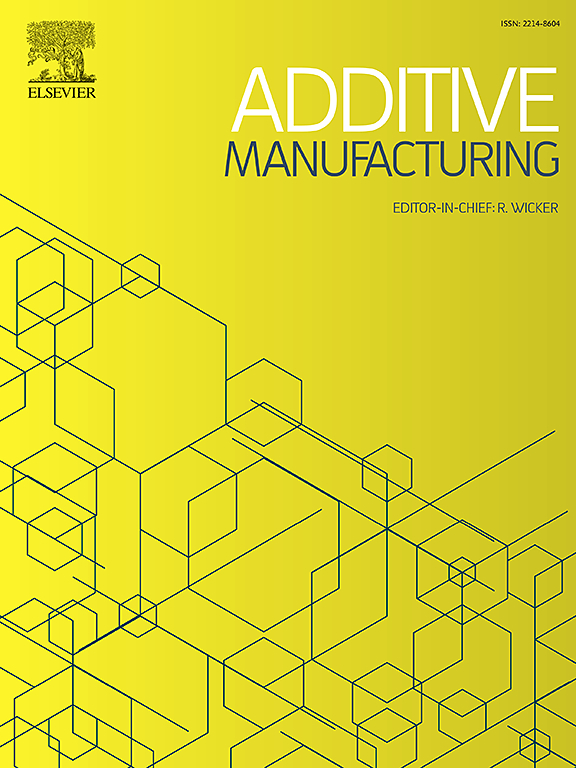具有无序梯形-菱形十二面体结构的添加式制造多孔 Ti-6Al-4V 合金的能量吸收能力增强且各向异性较低
IF 10.3
1区 工程技术
Q1 ENGINEERING, MANUFACTURING
引用次数: 0
摘要
增材制造(AM)可制造出具有出色特性的多孔金属,用于轻质结构应用和能量吸收。多孔金属的力学性能受孔隙率、晶胞形状、晶胞尺寸和加载方向等因素的影响。本研究探讨了通过激光粉末床熔融(L-PBF)工艺制造的具有有序和无序晶胞结构的多孔 Ti-6Al-4V 样品。我们系统地研究了它们在不同规则度下的各向异性压缩行为。结果表明,具有有序蜂窝结构的样品在 Z 轴压缩下具有更高的抗压强度,但在 X 轴和 Y 轴压缩下容易形成剪切带,从而显著降低强度。随着规整度的降低,剪切带也会减少,从而使所有方向的塑性变形更加均匀。值得注意的是,当规则系数 R = 0.8 时,样品表现出最佳的机械性能,包括最高的塑性塌陷强度和能量吸收能力。降低规则度也会降低多孔结构的各向异性,在 R = 0.4 时各向异性最小;但在 R = 0.8 时,整体机械性能达到最佳。调整多孔结构的规则性是实现各向同性和优化机械性能的关键,为轻质结构和能量吸收的实际应用提供了显著优势。本文章由计算机程序翻译,如有差异,请以英文原文为准。
Enhanced energy absorption and low anisotropy of additively manufactured porous Ti-6Al-4V alloy with disordered trapezo-rhombic dodecahedron structures
Additive manufacturing (AM) enables the fabrication of porous metals possessing outstanding characteristics for lightweight structural applications and energy absorption. The mechanical properties of porous metals are influenced by factors such as porosity, cell shape, cell size, and loading direction. This study explores porous Ti-6Al-4V samples with both ordered and disordered cellular structures, manufactured via the laser powder bed fusion (L-PBF) process. We systematically investigate their anisotropic compression behavior under varying degrees of regularity. Results indicate that samples with ordered cellular structures demonstrate higher compressive strength under z-axis compression but are susceptible to shear band formation under x- and y-axis compression, significantly reducing strength. As regularity decreases, shear bands diminish, leading to more uniform plastic deformation across all directions. Notably, at a regularity coefficient R = 0.8, the samples exhibit optimal mechanical performance, including the highest plastic collapse strength and energy absorption capacity. Decreasing regularity also reduces the anisotropy of the porous structures, with the lowest anisotropy observed at R = 0.4; however, the optimal overall mechanical performance is achieved at R = 0.8. Adjusting the porous structure regularity is key to achieving isotropy and optimizing mechanical properties, offering significant advantages for practical applications in lightweight structures and energy absorption.
求助全文
通过发布文献求助,成功后即可免费获取论文全文。
去求助
来源期刊

Additive manufacturing
Materials Science-General Materials Science
CiteScore
19.80
自引率
12.70%
发文量
648
审稿时长
35 days
期刊介绍:
Additive Manufacturing stands as a peer-reviewed journal dedicated to delivering high-quality research papers and reviews in the field of additive manufacturing, serving both academia and industry leaders. The journal's objective is to recognize the innovative essence of additive manufacturing and its diverse applications, providing a comprehensive overview of current developments and future prospects.
The transformative potential of additive manufacturing technologies in product design and manufacturing is poised to disrupt traditional approaches. In response to this paradigm shift, a distinctive and comprehensive publication outlet was essential. Additive Manufacturing fulfills this need, offering a platform for engineers, materials scientists, and practitioners across academia and various industries to document and share innovations in these evolving technologies.
 求助内容:
求助内容: 应助结果提醒方式:
应助结果提醒方式:


